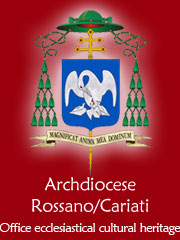Codex Purpureus Rossanensis
Codex Purpureus ( Introduction)
Codex Purpureus is an illuminated Greek evangeliary containing the whole Gospel of Matthew, almost all the gospel of Mark, of which only verses 15- 20 are missing , and a part of Eusebio’s letter to Copiano about the concordance of the gospels. It is an anonymous text( the authors are unknown) and mutilated . Of the original 400 sheets , only 188 of decorated parchment dyed in purple remain . The handwriting in which it is written is the capital Biblical or Greek uncial , with words in scriptio continua ( with no separation of the letters ), without accents, breathings, punctuation marks, except for the full stop- punctum, which marks the passing from a period to the other.
The text is distributed on two columns of twenty lines , the first three of which , making up the incipit of the Gospels, have the characters in gold, while the rest is in silver. The illuminations kept in the codex are fifteen. Twelve of them (I,II, II, IV, V, VI, VII, X, XI, XII, XIII), represent episodes of the life of Christ, one reproduces the Canon of concordance of the Evangelists (IX), while the last is a portrait of Mark.
There are no elements to establish with certainty the dating of the Codex Purpureus , the place in which it was made and the identity of the person who brought it to Rossano.
Most of the experts, basing themselves on the style of the manuscript, for the dating, agree on a period between the IV and the VI-VII. century. The most substantiated century is the VI. From the comparison with other two artefacts of the same period , of uncertain location, we can deduce that probably the Codex was made in Syria, maybe in Antioch. It is assumed that the migratory wave of the Eastern Greek monks of the VII c. , because of the first iconoclasm, led to Rossano a group of monks who kept the Holy Text. But also a noble aristocrat might have brought it to Rossano from the court of Byzantium.
The text was mentioned for the first time in 1846 by journalist Cesare Malpica and was scientifically studied in 1879 by the German Oscar von Gebhardt and Adolf Harnack, who submitted it to the attention of the international culture. The Codex Purpureus Rossanensis is in the list of the nominations to be recognized by Unesco among the excellent property of the world artistic heritage.

